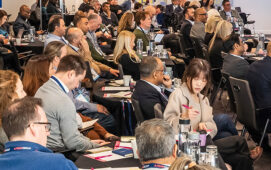Before one can accurately measure latency across a network, it’s important to make sure that all the devices connected to that network are running to precisely the same time. Endace recently rolled out support for the IEEE1588 specification, designed to achieve that synchronisation. And alongside the technology, the company also launched its new positioning as the “Official Timekeepers of the Low Latency Race.” IntelligentTradingTechnology.com asked Endace Technical Marketing Manager Paul Doyle about 1588 and the new focus.
IntelligentTradingTechnology.com: Let’s start with the basics – what is IEEE1588?
Paul Doyle: 1588 or, as some call it, Precision Timing Protocol is something out of the IEEE that describes a way of synchronising lots of timing devices, or rather the clocks used in the timing devices, to a really accurate common time source and it does this over Ethernet wiring! The sort of wires that are in everyone’s buildings these days.
ITT: Why is keeping devices in sync important?
Paul: When you’re doing things like measurement of latency or monitoring, you’re going to be using probes at different points around the network, and if you want accurate results for when data leaves and arrives, you need to make sure that all the devices that time-stamp the packets are in step and time with each other. So once you set the time and date on all of your probes, you need to keep them all instep. You have to do this as well, because every clock drifts and in most systems the clocks are inexpensive so they drift quite a lot, much more than say an expensive atomic clock you might get in a space craft or satellite.
ITT: What practical issues does IEEE1588 overcome?
Paul: The problem that has always faced anyone trying to measure things like latency is how to distribute a common timing source to the probes to keep them all in step. You need as accurate a source as possible and one that is the same anywhere. Something like GPS is very good for this because you can get your sync signals anywhere you can use a GPS, but actually having lots of GPS units on buildings and in places that they can get a clear view of the sky is pretty hard in places like New York or London.
That’s where 1588 comes in. As I was saying at the beginning, 1588 travels over Ethernet wires, in essence the Ethernet is like the telephone wire between the sender and receiver. So that means you can place one GPS on the roof, and then distribute the timing signals all over the building using the wiring that is already in place. Most buildings have miles of unused Ethernet through the walls and floors, so it’s pretty easy to set the whole thing up.
ITT: How has Endace implemented IEEE1588?
Paul: Our DAG technology allows us to capture and time stamp packets with no additional latency, so it wasn’t a far stretch to take the requirement of 1588 and add that to the capabilities of one of our cards. We have two forms, one that is a receiver and sits in the probes you have measuring and time stamping in your network, and the other is the main system that actually does the distribution of timing signals over Ethernet wiring. That’s part of the attraction for our customers, it’s simple and if you’re using our products already, which many exchanges and trading firms are, it’s pretty easy to implement as well.
ITT: What does an existing Endace customer need to do to take advantage of IEEE1588 functionality?
Paul: If you’re using Endace probes already, then it’s pretty much the addition of one of our 1588 enabled DAG cards to the probes you have in place at the moment, and the addition of our “GrandMaster” box. The GrandMaster is the box that sits at the top and is connected to the GPS and the same Ethernet wires that the probes are connected to. The GrandMaster sends out the sync signals over the Ethernet and keeps all the other devices in step.
ITT: How does IEEE1588 support Endace’s positioning as the “Official Timekeepers of the Low Latency Race.”
Paul: Why were Omega recently seen as Official Timekeepers in Beijing? It’s because they are known for reliability and accuracy. When there’s a race, somebody’s gotta’ be trusted to keep time. At Endace we are all about reliable, accurate, zero impact measurement of time. We have the only technology that allows you to time stamp a packet down to nano second accuracy, and do it with zero impact on the data flow.
Many of the software vendors out there delivering the latency measurement applications base their solutions on Endace technology. Our 1588 announcement furthers our position as the standard that others are now measured against. If you think about the issues facing most of the financial services world, it’s how much faster can I get with my trades, my data feeds?
Obviously you can keep upgrading your computing platforms, but that gets expensive, so the next best thing is to optimise your networks, look for problems, latency, jitter and so on. The problem we saw facing our customers, as the need for accuracy goes from milliseconds to microseconds, is how to get that common timing source to all of our systems in a cost effective way. 1588 is perfect for network admins to quickly set up a really accurate timing network.
We provide the reliable measuring system and a way of synchronising all the measurement system, using wiring that’s already in place. For a more detailed discussion of clock synchronisation.
Subscribe to our newsletter




